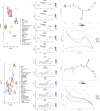Genetic variation in patent foramen ovale: a case-control genome-wide association study
- PMID: 39872005
- PMCID: PMC11769951
- DOI: 10.3389/fgene.2024.1523304
Genetic variation in patent foramen ovale: a case-control genome-wide association study
Abstract
Background: Patent foramen ovale (PFO) is a congenital defect between the atria, resulting in abnormal hemodynamics. We conducted a genome-wide association study (GWAS) to identify common genetic variants associated with PFO.
Methods: We performed a whole genome sequencing in a discovery cohort of 3,227 unrelated Chinese participants screened for PFO via contrast transthoracic echocardiography (cTTE). Single-nucleotide polymorphisms (SNPs) associated with PFO were further validated by Sanger sequencing and subsequently were evaluated in a validation cohort. Expression quantitative trait loci (eQTL) analysis was conducted using the GTEx database. Single-cell sequencing analyses with pseudotime trajectory modeling were employed to evaluate their expression in human fetal hearts.
Results: The case-control GWAS of discovery cohort ultimately included 517 cases and 517 demographically matched controls. Of the 7,040,407 variants assessed, we identified rs1227675732 (OR = 2.903; 95% CI, 1.961 to 4.297; p = 3.05 × 10-8), rs62206790 (OR = 2.780; 95% CI, 1.864 to 4.146; p = 2.02 × 10-7), rs879176184 (OR = 2.724; 95% CI, 1.822 to 4.073; p = 4.30 × 10-7) and rs13115019 (OR = 2.437; 95% CI, 1.702 to 3.488; p = 5.80 × 10-7) as high-risk variants for PFO, while rs57922961 (OR = 0.5081; 95% CI, 0.388 to 0.666; p = 6.82 × 10-7) was identified as protective variant. These variations were replicated in the validation cohort (111 cases and 152 controls). Single-cell sequencing showed that CNOT2, KCNMB4, MLLT10, IGBP1, and FRG1 were highly expressed with significant changes during heart development.
Conclusion: The identification of susceptible loci for PFO might provide insights into the pathogenesis of PFO and contribute to understanding heart development.
Clinical trial registration: https://www.chictr.org.cn/showproj.html?proj=40590, identifier ChiCTR1900024623.
Keywords: common variants; genome-wide association study; heart development; patent foramen ovale; single-cell sequencing.
Copyright © 2025 Dong, Li, Ai, Geng, Tang, Peng, Tang, Wang, Tian, Bu and Chen.
Conflict of interest statement
The authors declare that the research was conducted in the absence of any commercial or financial relationships that could be construed as a potential conflict of interest.
Figures





Similar articles
-
Transthoracic contrast echocardiography using vitamin B6 and sodium bicarbonate as contrast agents for the diagnosis of patent foramen ovale.Int J Cardiovasc Imaging. 2017 Aug;33(8):1125-1131. doi: 10.1007/s10554-017-1088-0. Epub 2017 Feb 7. Int J Cardiovasc Imaging. 2017. PMID: 28176181
-
Diagnostic Value of Micro-Bubble Transcranial Doppler Combined with Contrast Transthoracic Echocardiography in Cryptogenic Stroke Patients with Patent Foramen Ovale.Neurol India. 2022 Jul-Aug;70(4):1403-1406. doi: 10.4103/0028-3886.355122. Neurol India. 2022. PMID: 36076635
-
Resting arterial hypoxaemia in subjects with chronic heart failure, pulmonary hypertension and patent foramen ovale.Exp Physiol. 2016 May 1;101(5):657-70. doi: 10.1113/EP085657. Exp Physiol. 2016. PMID: 26990684
-
Techniques for Identifying a Patent Foramen Ovale: Transthoracic Echocardiography, Transesophageal Echocardiography, Transcranial Doppler, Right Heart Catheterization.Cardiol Clin. 2024 Nov;42(4):473-486. doi: 10.1016/j.ccl.2024.01.005. Epub 2024 Feb 29. Cardiol Clin. 2024. PMID: 39322338 Review.
-
The diagnostic value of contrast-enhanced transcranial Doppler and contrast-enhanced transthoracic echocardiography for right to left shunt in patent foramen ovale: a systematic review and meta-analysis.Front Neurol. 2024 Aug 2;15:1447964. doi: 10.3389/fneur.2024.1447964. eCollection 2024. Front Neurol. 2024. PMID: 39157064 Free PMC article.
Cited by
-
Analysis of Software Read Cross-Contamination in DNBSEQ Data.Biology (Basel). 2025 Jun 9;14(6):670. doi: 10.3390/biology14060670. Biology (Basel). 2025. PMID: 40563921 Free PMC article.
References
-
- Angeli S., Carrera P., Del S. M., Assini A., Grandis M., Biancolini D., et al. (2001). Very high prevalence of right-to-left shunt on transcranial Doppler in an Italian family with cerebral autosomal dominant angiopathy with subcortical infarcts and leukoencephalopathy. Case Rep. J. Article. Eur. Neurol. 46 (4), 198–201. 10.1159/000050804 - DOI - PubMed
LinkOut - more resources
Full Text Sources

